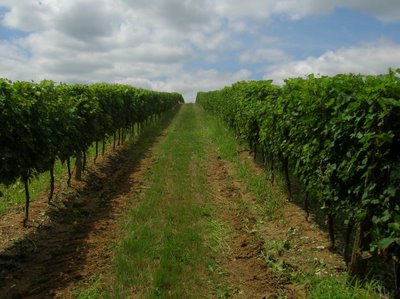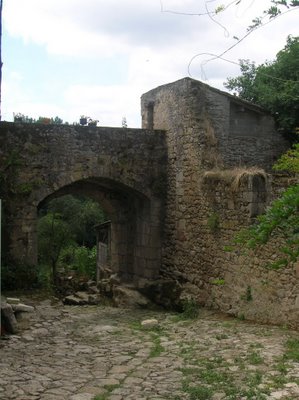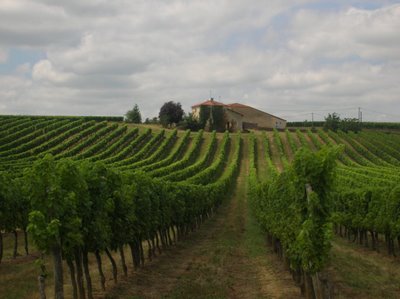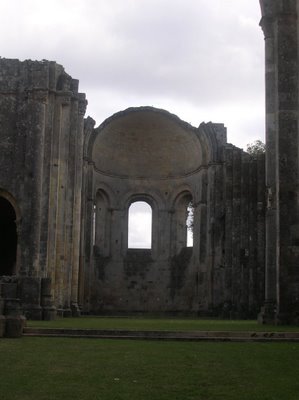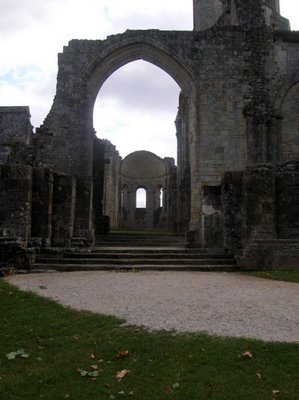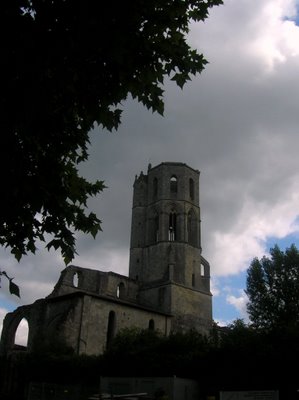On my sixth day in France we just stayed in the city as my cousin and her husband had planned on taking Ashley and I to dinner that night before they left for their big trip to the Pyrenees the next day. My cousin suggested our going to the Musee d'Aquitaine in the afternoon, which we were looking forward to even though we knew that we would not be able to understand the artifact/exhibit descriptions. Incidentally, we solved that problem when we each got an audio guide in English which, thankfully, were available*. We then started out on our afternoon adventure with the first exhibit in this fascinating museum. It stared with what was the first known human settlement in the Aquitaine region and ended up in "modern day" 1800's. What an extensive history the people of Bordeaux have! From it's first settling by an ancient Celtic tribe, to Roman rule, to English rule and finally French rule. And through it all were the amazing threads of an ever changing human population and way of living. Their beliefs varied and changed from generation to generation: from paganism, to Protestantism, to Catholicism to present day agnosticism. Thousands of years of human history, and the Musee d'Aquitaine was by no means exhausting the region's history, even though the museum did feel at times as though it would never end. Just when I thought I had nearly done with it, I noticed that the "modern" history continued on a second floor. I was very much fascinated by the exhibits and stopped at nearly every artifact to study and view it, but had to cut the second floor short due to time constraints. My cousin had remarked that the musee was a "great, small museum" and so I had expected it to be just that. I was unprepared for the amount of historical artifacts and history in that building and was surprised that my cousin had thought it small, but then realized that I, coming from the USA, (and Texas at that) was completely unused to any museum with a local history that extends beyond a more recent 500 years ago. :-) One of the best parts of the museum was being able to view ancient Roman civilization artifacts: mosaics, statues, building remains, etc.,. and most of them were inscribed with ancient Latin words, a few of which I could translate. These things I could never have seen other than by a small, traveling exhibit in a local museum or by traveling to Rome itself, so it was quite a treat for this history lover to be there.
After our quiet afternoon in the museum and just before catching a crowded tram to get back to Merignac, we stopped at a coffee shop near our tram stop to order some caffeine-er, coffee-to give us a perk as we were going to be out very late that night**. I stepped up to order and started off with my practice-perfected sentence that my cousin had drilled me in before letting me loose in the city: "Dezolais, Je ne parlez pas Francais". The woman behind the counter nodded and said in English "I understand". I was so relieved to hear it that I then asked her if she spoke English. Suddenly she seemed to get a little panicky and began to call out for a translator, much to my embarrassment. After all, who needs a translator when you are just ordering an espresso beverage?! A British man and his lady walked up and asked what the problem was. I must have been tongue tied with embarrassment, I could only get out that I wanted a cappuccino. I really wanted to tell him that his help was not necessary, but I just meekly let him take over. He ordered, then turned to me and said "That wasn't difficult to order, was it?"and taking his lady companion by the arm, they walked out. By the tone of his voice and look on his face, he obviously thought me to be another stupid American tourist. I wish I had been a little more like an American tourist at that moment and just taken charge of the situation before I was so humbled in front of the Europeans, but oh well. I comfort myself with thinking that it was the idiotic French woman that started the fuss in the first place! :-)
On arriving back in Merignac, we only had to wait for the babysitter to arrive before we left again for dinner. We went back downtown and tried a restaurant on the babysitter's recommendation. It was very tiny with only about 6 tables, and small ones at that. One waitress was sufficient to serve everyone, and she was my first encounter with a snobbish, stereotypical French person. I hadn't really encountered any before her, but she was very put out to be serving us and she made it obvious. She waited on her other customers with a smile and even flirted with the men. She sighed at us if we asked for water (which she should have served us as it is customary in all restaurants to receive a free carafe of water with any beverage you order), she was impatient with our ordering and she made it obvious that she was just plain put out to serve us, even though we were able to communicate with her easily through my cousin's husband, who is fluent in French. She was never out-right rude, just a snob. It is people like her that give the French a bad reputation, just as it is our obnoxious American tourists that give us a bad reputation to Europeans. People just never stop to think that someone from the same country could possibly be different! I say that for the Americans as well as the French. If you were to take that one disagreeable waitress and classify all of the French as being like her, that would be very unfair to them. The same applies to Americans in Europe, and although some Europeans will look beyond the stereotype, there are still some who treat Americans as all the same, which is unfair to the rest of us. Especially those of us who are on our best behavior while abroad so as not to give our country or, more especially, Christianity a bad name. I digress from the subject, however, and will now proceed with my tale...
It was a fixed price menu and we were given about four options for each course. For my salad I chose the goat cheese and honey salad, which was served warm and soft, and I spread the extra cheese and honey over delicious bread that the French are so adept at making. For the main course I had salmon and roasted vegetables, then for dessert a lemon tart which was garnished with whipped cream on the side. Ahhhh, satisfaction was never so palatable. It was worth all of the French snobs in Bordeaux just to eat their food and partake of a new way of living - the kind of life that Americans long for but never can achieve with all of our hectic, busy lifestyles. It was absolutely delightful to linger over dinner for two or three hours and never be rushed. The food was fresh and tasty as so many of the restaurants in Bordeaux rely heavily on their local farmers and fishermen to provide them with their food needs. Believe me, it makes all the difference in the world.
I wish that I had taken the camera along that day, but it was unfortunately left in Merignac both of the times that we went out, so no pictures of the museum or dinner. Just use my words and your imagination, if you desire, to picture a very eventful day in the life of this American abroad.
*They were nice to have but not really much help when it came down to it, as in every room there was only one object (sometimes two) which we got info on from the guide. Nice for that one object, but every room had so many artifacts that it was quite frustrating not to know their historical significance, and so we concluded that the guides were a waste of money and that it is better by far to either 1)know French, or 2)have a bilingual person follow you around the museum. :-)
**The French eat dinner between 8 and 10 o'clock pm
Monday, August 28, 2006
Saturday, August 26, 2006
Bad Blogger!
I had spent a good part of my morning writing about Day #6 in France. As I neared the end of my description of that day, I decided to save the post and finish it later as I still had the evening's events of that day to write about. I clicked "Save as Draft", then checked it in my drafts page to be sure it was really saved (I have had one too many bad experiences). It was, so I let it be until this evening when I signed back on and noticed - horrors! - that my post wasn't there. I got a little panicky and tried to recover the post, but it was as though it didn't exist. There wasn't even a saved blank (like another of my bad experiences). It just isn't visible and I'm very baffled as to why. This is just another in the continuation of bad Blogger experiences and I am seriously considering switching to another blog server. Anyway, I hope to resolve the problem, whatever it is, and resume my saga on Monday.
See you then!
See you then!
Wednesday, August 16, 2006
Saint Emilion
This is the church of Saint Emilion. Inside this magnificent church were many old artifacts, lovely architecture and chapels surrounding the perimenter of the cathedral that were open to exploration. We didn't dare touch anything, and barely had voices for speaking in this hushed and sacred place. Fresh flowers perfumed the air and when a choir wasn't singing, a priest was praying in French (I was disappointed it wasn't Latin - it would have been more historically accurate) over some sort of intercom system. Obviously it was all pre-recorded sounds, but it really added to the atmosphere of this ancient church. People walked around paying homage and I wished that I knew more about catholisicm as there were so many interesting objects in the church that I could not find any explanation for. It was sad to stand in the center of so much beauty and realize how many people over the hundreds of years it has been there have been led into a false and errant theology. The one tragedy in the midst of the beauty...
It was sad to stand in the center of so much beauty and realize how many people over the hundreds of years it has been there have been led into a false and errant theology. The one tragedy in the midst of the beauty...

St. Emilion is full of narrow, winding and especially steep streets, but this one took the prize when it came to attempting to walk up or down it without slipping on the damp stones and all the time maintaing a balance so that you would not topple over and roll down hill, hence the handrails in the center, which were my lifesaver...

Saint Emilion in bloom

Steps leading down to the catacombs beneath the city. My cousin Laura, Ashley and I took a guided tour of these catacombs, full of intricate paintings and ancient carvings ,and still containing the bones of decomposed saints and citizens long since gone. Most intriguing was the stone over a stream upon which only a very special person could be placed where their body was allowed to decompose and gradually drop into the rushing waters below. Most sad were the tiny holes where the infants were laid to rest. Most funny was the story of how one part of the catacombs were discovered: a local man wishing to enlarge his wine cellar ended up instead with these ancient catacombs! Ah, if only I could enlarge a cellar and come across something so historic instead! We also viewed St. Emilion's hermitage. There was a stone chair, a stream for drinking water , and where he got his food no one was able to tell us, although my cousin's husband says that probably the followers of this legendary hermit would have provided his needs. Anyway, the hermitage was where St. Emilion studied and lived for 17 years. What a lonely, solitary life! What was extremely fascintaing about the city of Saint Emilion was the fact that the church was carved and built from one rock, as was the city, and that some of this rock also went into surrounding villages and even as far as Bordeaux!
 It was sad to stand in the center of so much beauty and realize how many people over the hundreds of years it has been there have been led into a false and errant theology. The one tragedy in the midst of the beauty...
It was sad to stand in the center of so much beauty and realize how many people over the hundreds of years it has been there have been led into a false and errant theology. The one tragedy in the midst of the beauty...
St. Emilion is full of narrow, winding and especially steep streets, but this one took the prize when it came to attempting to walk up or down it without slipping on the damp stones and all the time maintaing a balance so that you would not topple over and roll down hill, hence the handrails in the center, which were my lifesaver...

Saint Emilion in bloom

Steps leading down to the catacombs beneath the city. My cousin Laura, Ashley and I took a guided tour of these catacombs, full of intricate paintings and ancient carvings ,and still containing the bones of decomposed saints and citizens long since gone. Most intriguing was the stone over a stream upon which only a very special person could be placed where their body was allowed to decompose and gradually drop into the rushing waters below. Most sad were the tiny holes where the infants were laid to rest. Most funny was the story of how one part of the catacombs were discovered: a local man wishing to enlarge his wine cellar ended up instead with these ancient catacombs! Ah, if only I could enlarge a cellar and come across something so historic instead! We also viewed St. Emilion's hermitage. There was a stone chair, a stream for drinking water , and where he got his food no one was able to tell us, although my cousin's husband says that probably the followers of this legendary hermit would have provided his needs. Anyway, the hermitage was where St. Emilion studied and lived for 17 years. What a lonely, solitary life! What was extremely fascintaing about the city of Saint Emilion was the fact that the church was carved and built from one rock, as was the city, and that some of this rock also went into surrounding villages and even as far as Bordeaux!

The Tour (tower)
This is the church tower that we all climbed. In all the times that my cousin had been to St. Emilion, this was the first that the tower was open to the public. It was by no means difficult to climb, and we were treated to fantastic views and delicious, cooling breezes at the top.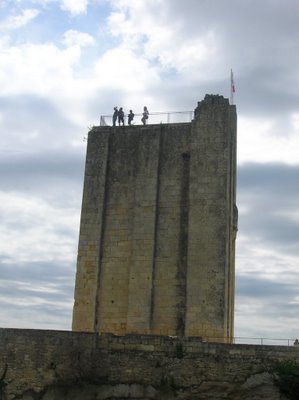 Inside the tower you could see where prisoners were formerly kept, and the latrines were gated off, but the smell was still strong, even after all these years! There were little, man sized holes in the sides of the walls on the outside of the tower on our descent, and we wondered if this was where the guards crouched into when on duty...
Inside the tower you could see where prisoners were formerly kept, and the latrines were gated off, but the smell was still strong, even after all these years! There were little, man sized holes in the sides of the walls on the outside of the tower on our descent, and we wondered if this was where the guards crouched into when on duty...
The tower also served as a city hall and I've forgotten what all else, but it has had many uses over it's existence, not the least of which it now treats visitors like us to spectacular city and surrounding vineyard views...

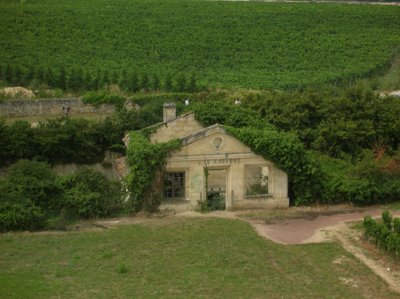

 Inside the tower you could see where prisoners were formerly kept, and the latrines were gated off, but the smell was still strong, even after all these years! There were little, man sized holes in the sides of the walls on the outside of the tower on our descent, and we wondered if this was where the guards crouched into when on duty...
Inside the tower you could see where prisoners were formerly kept, and the latrines were gated off, but the smell was still strong, even after all these years! There were little, man sized holes in the sides of the walls on the outside of the tower on our descent, and we wondered if this was where the guards crouched into when on duty...The tower also served as a city hall and I've forgotten what all else, but it has had many uses over it's existence, not the least of which it now treats visitors like us to spectacular city and surrounding vineyard views...



St. George
On our way home we found this chat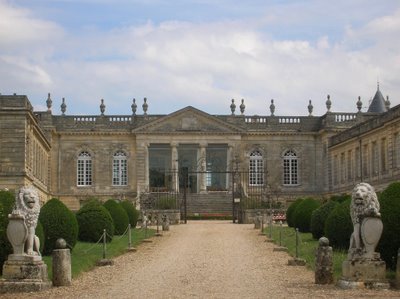 eau. It looks magnificent in this picture, but you should have stood in the courtyard, looking up at those front steps which led to an enclosed area richly decorated, and beyond which you could see through to the inside of the chateau. Surrounding us were the two wings of the chateau, and looking in, as best as I could see from where I was standing, it seemed that the bedrooms and general living areas for the families were in those. I felt instantly transported into another century...
eau. It looks magnificent in this picture, but you should have stood in the courtyard, looking up at those front steps which led to an enclosed area richly decorated, and beyond which you could see through to the inside of the chateau. Surrounding us were the two wings of the chateau, and looking in, as best as I could see from where I was standing, it seemed that the bedrooms and general living areas for the families were in those. I felt instantly transported into another century...
I could almost see carriages driving up to the entrance, the house glowing, servants here, there and everywhere, ladies in magnificent gowns, men in powdered wigs, much merrymaking and celebrating, in grand French style...
... And then the owner and his secretary came out from one of the house's many entrances and didn't seem too pleased to see us, so we left. The spell was broken, and I was once again in the twenty first century, heading back to Bordeaux in the Citroen, our modern day conveyance...
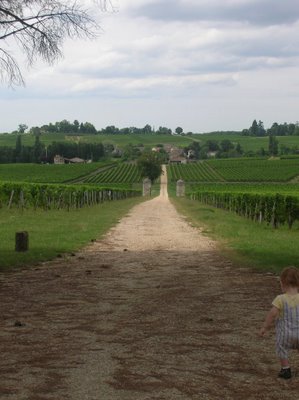
Before we left, Ashley snapped this picture which is the view from the chateau's grand entrance, which you see above. When we got home, I found this chateau in a guide book, and found out that it is actually quite famous, not just for the wine it produces, but for the chateau as well. That is Henrik in the corner, looking as if he could have walked on down and out that entrance, back to the little winding road that carried us on to Bordeaux.
 eau. It looks magnificent in this picture, but you should have stood in the courtyard, looking up at those front steps which led to an enclosed area richly decorated, and beyond which you could see through to the inside of the chateau. Surrounding us were the two wings of the chateau, and looking in, as best as I could see from where I was standing, it seemed that the bedrooms and general living areas for the families were in those. I felt instantly transported into another century...
eau. It looks magnificent in this picture, but you should have stood in the courtyard, looking up at those front steps which led to an enclosed area richly decorated, and beyond which you could see through to the inside of the chateau. Surrounding us were the two wings of the chateau, and looking in, as best as I could see from where I was standing, it seemed that the bedrooms and general living areas for the families were in those. I felt instantly transported into another century...I could almost see carriages driving up to the entrance, the house glowing, servants here, there and everywhere, ladies in magnificent gowns, men in powdered wigs, much merrymaking and celebrating, in grand French style...
... And then the owner and his secretary came out from one of the house's many entrances and didn't seem too pleased to see us, so we left. The spell was broken, and I was once again in the twenty first century, heading back to Bordeaux in the Citroen, our modern day conveyance...

Before we left, Ashley snapped this picture which is the view from the chateau's grand entrance, which you see above. When we got home, I found this chateau in a guide book, and found out that it is actually quite famous, not just for the wine it produces, but for the chateau as well. That is Henrik in the corner, looking as if he could have walked on down and out that entrance, back to the little winding road that carried us on to Bordeaux.

Friday, August 11, 2006
Au Revoir, France
After a very long day of flying and making connections on Wednesday I finally made it home late in the evening, more than 20 hours after I had started from Bordeaux. I was pretty tired of security, customs, waiting and more waiting at airports, and the long, long time of sitting on planes. The security in London on Wednesday was very tight, so I can only imagine what it is now. I have never had to go through so much security in one airport at any one time before. I think we went through at least two security checks before actually getting to the gate where another check was performed before we were allowed into our gate's waiting area. Customs at Raleigh/Durham was a very long process, and we were subjected to several security checks there as well since we had to get our baggage, go through customs and then re-check it for our flight here. This is nothing, however, compared to what people are going through today, and much more what they went through yesterday. I am so grateful to have been on one of the last American Airlines flights from London before the arrests were made there. I can't imagine the horrors of trying to get home in the aftermath and confusion. We would have made it, certainly, but with a lot of difficulty. Also, I would have been upset to have not been able to take my electronics and extra travel comforts on board, and to have not been able to keep my bag with gifts and valuables with me on the plane. But it didn't happen to me, thankfully; I am here and still trying to get my body back on Central time and trying to adjust to pastry and French food withdrawal (not easy to go cold-turkey, let me tell you!) and also attemtping to adjust to the heat from which I was mercifully free from for over two weeks.
I will continue to post pictures and tales of life in France as I have time. I am very behind due to many problems posting with Blogger while overseas. I ceased to count all of the posts I lost in cyberspace and which I had no inclination to write all over again after having spent so much time on them in the first place before losing them to the great unknown and unretrievable cyberworld. In the meantime, I am spending time with my family and readjusting to Texas life, weather and food. :-)
I will continue to post pictures and tales of life in France as I have time. I am very behind due to many problems posting with Blogger while overseas. I ceased to count all of the posts I lost in cyberspace and which I had no inclination to write all over again after having spent so much time on them in the first place before losing them to the great unknown and unretrievable cyberworld. In the meantime, I am spending time with my family and readjusting to Texas life, weather and food. :-)
Tuesday, August 08, 2006
Entre-Deux-Mers
We had passed the mill when my cousin called us to turn around and look. Barely visible from the path due to it's being neatly camoflauged into it's surroundings (thanks to nature's hundreds of years of growth ), it was still hard to spot from where we stood in a vineyard. We got up close to take a better look and found the doors open.  Looking inside we had to use our imaginations to fill in the missing pieces everywhere...
Looking inside we had to use our imaginations to fill in the missing pieces everywhere...

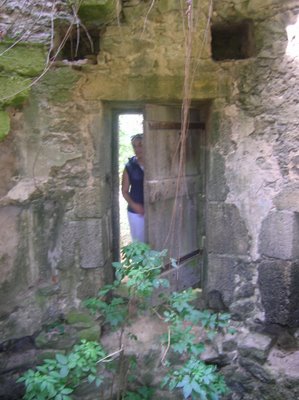

 Looking inside we had to use our imaginations to fill in the missing pieces everywhere...
Looking inside we had to use our imaginations to fill in the missing pieces everywhere... 


Monday, August 07, 2006
Castelmoron d'Albret
 After visiting the abbey, we came on to this medieval village. Very old and very small, this village still remains inhabited today. The buildings line this old street, so narrow that three people walking side by side fit very comfortably. These are two way streets, which is a little incredulous to me as only one small (European small even!) car could possibly fit on the streets.
After visiting the abbey, we came on to this medieval village. Very old and very small, this village still remains inhabited today. The buildings line this old street, so narrow that three people walking side by side fit very comfortably. These are two way streets, which is a little incredulous to me as only one small (European small even!) car could possibly fit on the streets.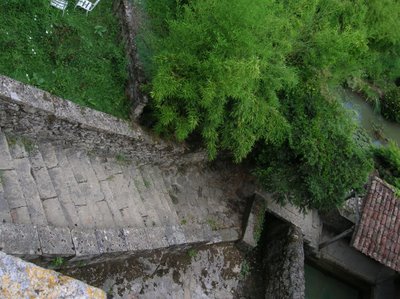
These are the steps which lead down to the old bathing place:

Soap anyone? :-)
Saturday, August 05, 2006
abbaye de La Suave-Majeure
Last Saturday we took a day trip into the countryside. Our first stop was at this ruined abbey, a mere shadow today of what must have been a beautiful and glorious building in it's former days. Building was begun on it in 1000 something AD, and was actually completed a few centuries later, I believe. What once was a bustling monastery and village refuge is now a crumbling remain, the last of which we can get something of an idea of what it must have been like hundreds of years ago to have lived here, or traveled through it...
Imagine that you are a pilgrim in the year 1500 on your way to Santiago de Compostela (Saint James of Compostela) to pay homage to what your religion believes is one of the holiest sites in the world. It is one of only three pilgrimages said to forgive all sins; the other ones being the Via Francigena to Rome and Jerusalem. Your destination is the Cathedral of Santiago de Compostela, where the bones of Saint James the Great are said to be buried beneath the altar in the crypt of the cathedral.
This abbey is one of many holy stops on your way. Holy relics will be on display and the priests will offer mass. France has granted the abbey diplomatic immunity and anyone who enters it's walls is safe from political upheavals for as long as they stay. This does not stop foreign attacks, however, and often Spanish armies will raid the village and attack the abbey. There is a tower in the abbey where guards keep watch over the village and the many miles around and beyond it. If any foreign army comes to attack the villagers will be warned and will gather within the abbey's strong walls for protection. At other times the villagers will come to the abbey for fairs and markets. You are not a villager, though, and so you stay just long enough to pay homage to the holy relics and you continue on your way to Spain, despite the risks to travelers. Your only protection lies in the abbeys such as this one on the way. But you are a faithful pilgrim and devoted to your religion. You would risk anything rather than not receive absolution and forgiveness of sins at the end of your pilgrimage.
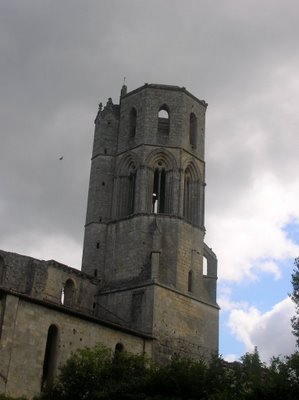

Imagine that you are a pilgrim in the year 1500 on your way to Santiago de Compostela (Saint James of Compostela) to pay homage to what your religion believes is one of the holiest sites in the world. It is one of only three pilgrimages said to forgive all sins; the other ones being the Via Francigena to Rome and Jerusalem. Your destination is the Cathedral of Santiago de Compostela, where the bones of Saint James the Great are said to be buried beneath the altar in the crypt of the cathedral.
This abbey is one of many holy stops on your way. Holy relics will be on display and the priests will offer mass. France has granted the abbey diplomatic immunity and anyone who enters it's walls is safe from political upheavals for as long as they stay. This does not stop foreign attacks, however, and often Spanish armies will raid the village and attack the abbey. There is a tower in the abbey where guards keep watch over the village and the many miles around and beyond it. If any foreign army comes to attack the villagers will be warned and will gather within the abbey's strong walls for protection. At other times the villagers will come to the abbey for fairs and markets. You are not a villager, though, and so you stay just long enough to pay homage to the holy relics and you continue on your way to Spain, despite the risks to travelers. Your only protection lies in the abbeys such as this one on the way. But you are a faithful pilgrim and devoted to your religion. You would risk anything rather than not receive absolution and forgiveness of sins at the end of your pilgrimage.


 The view of the countryside from the tower. That was my second tower to climb up. It was more narrow than the first, darker, very damp and on one level you had to walk through a dark, narrow walkway with a huge wooden door padlocked, but through which I could see what must have been a room formerly housing the abbey's bells.
The view of the countryside from the tower. That was my second tower to climb up. It was more narrow than the first, darker, very damp and on one level you had to walk through a dark, narrow walkway with a huge wooden door padlocked, but through which I could see what must have been a room formerly housing the abbey's bells.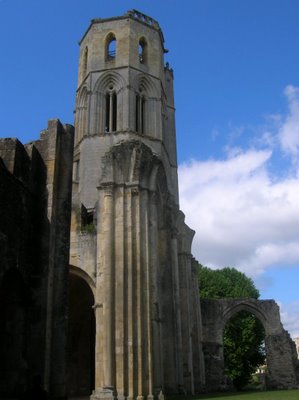

One of the walkways in the abbey.

See the many beautiful carvings in the stone? Every pillar had a story carved in pictures on it. Most were Bible stories, but oddly enough there were a few Greek myths as well. Possibly because the abbey took so long to build that the designs must have changed at least once, maybe more.

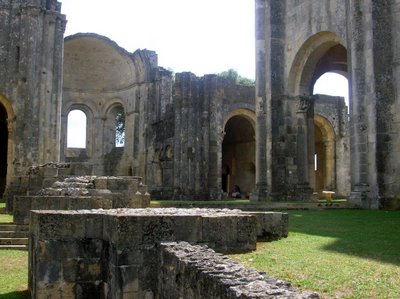 It is hard to believe that this was the interior of the abbey...
It is hard to believe that this was the interior of the abbey...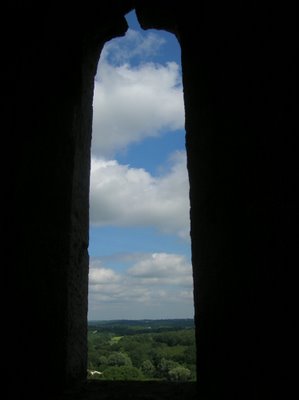 Another view from the tower taken through a window on a stairway that used to lead to another level of the tower, but is now gone. The stairway is still intact, but closed off. The window is still visible and we could see through it perfectly from where we stood on the tower. It seemed perfect for attempting to frame the countryside.
Another view from the tower taken through a window on a stairway that used to lead to another level of the tower, but is now gone. The stairway is still intact, but closed off. The window is still visible and we could see through it perfectly from where we stood on the tower. It seemed perfect for attempting to frame the countryside.

Subscribe to:
Posts (Atom)
